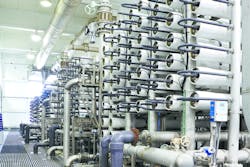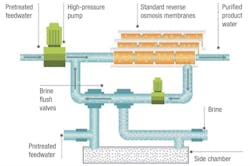Technological progress and population growth increases the need to generate water from available sources such as sea and brackish water. The technologies available for water production and desalination can be divided into two major types: membrane technology, primarily reverse osmosis (RO), and thermal technologies such as multiple effect distillation and multistage flash distillation. Over the last decade, membrane technology has become the preferred technology due to the relatively lower capital and operational expenditures compared to thermal technologies.
All desalination technologies produce the same byproduct — concentrate or brine. The amount of the produced brine varies depending on the water source to be desalinated. In seawater desalination plants, the brine constitutes almost 50 percent of the quantity of seawater that is pumped from the sea to the desalination plant. In brackish water desalination plants, the brine constitutes between 15 and 30 percent of the brackish water pumped to the desalination plant.
The produced brine has a negative environmental impact and should be discharged to authorized sites. Seawater brine is generally returned to the sea, while brackish water brine sometimes has to be pumped over long distances, discharged to evaporation ponds or injected into dedicated injection wells. Although the amount of brine in the brackish water desalination plants is relatively low, the brine discharge in these facilities is far more problematic.
Challenges with today’s brine management solutions
As more desalination facilities are established, the problem of brine discharge becomes increasingly severe, and it is necessary to minimize the amount of produced brine as much as possible. One of the solutions for brine minimization is salt extraction. This solution is preferable from an environmental point of view and will likely take over the market in the coming years. For this to happen, the technology must be economical. Meanwhile, it has been shown that the extraction of many salts such as chlorine, bromine, sodium hydroxide, calcium carbonate, magnesium hydroxide and magnesium oxide is technically feasible from seawater desalination brine. According to the WateReuse Research Foundation, the main factor that impedes salt recovery from seawater desalination brine is the economics of extraction. Additional factors include facility location, product purity, staffing, safety, material handling and storage.
The available alternative for brine minimization is a combination of technologies — reverse osmosis, followed by thermal evaporation, followed by thermal crystallization. Due to the significant differences in the cost of these technologies (see Table 1), the most economical approach would be to increase the load on the reverse osmosis as much as applicable and maximize its recovery, thus decreasing the size of the thermal crystallization unit to the minimum.
Table 1. Comparison of brine minimization technologies
Two factors generally limit the use of reverse osmosis technology: osmotic pressure and water chemistry, i.e., saturation of sparingly soluble salts in the produced brine such as calcium carbonate, calcium sulfate or silica. Seawater RO desalination plants already operate at the maximum threshold limit of the osmotic pressure, and no further brine minimization is possible with current reverse osmosis membranes. In brackish water desalination plants, the brine chemistry limits the amount of brine produced and acts as the main limiting factor in terms of the possible recovery. The final brine obtained at these facilities is far from the maximum threshold limit of the osmotic pressure. Therefore, in brackish water desalination plants, there is a clear potential for the use of reverse osmosis technology at much higher recoveries. If reverse osmosis technology can be upgraded to overcome the brine chemistry limitation, the upgraded RO technology can be used far more effectively before switching to more expensive thermal technologies.
Reverse osmosis technologies for brine management
The leading RO technologies that can overcome the brine chemistry limitation are:
• High efficiency reverse osmosis (HERO)
• Closed circuit desalination (CCD)
• MaxH2O DESALTER
The HERO process removes some of the sparingly soluble salts such as calcium carbonate and magnesium hydroxide and makes other salts, such as silica, more soluble. The process includes a weak acid cation exchanger to remove calcium and magnesium ions, as well as a degasifier to remove carbonate and bicarbonate ions. After removing these ions, the reverse osmosis can be operated at a high pH level at which silica is highly soluble. By removing the scaling potential of sparingly soluble salts, the HERO process minimizes the brine quantity as much as possible and reaches the maximum threshold limit of the osmotic pressure. The major drawback of this process is high chemical consumption. Chemicals are required for regeneration of the ion exchanger, hydrochloric acid is required to remove bicarbonates and carbonates in the degasifier, and sodium hydroxide is required in reverse osmosis to increase the solubility of silica.
Figure 1. AQUATECH’s high efficiency reverse osmosis (HERO) system. Graphic courtesy of IDE Technologies
The CCD process is a semibatch process where the brine is recirculated back to the feed and mixed with fresh feedwater. When maximum feed pressure is reached, the brine is discharged and fresh feedwater is fed to the system. This process improves the flow regime inside the RO membrane by cyclic operation and high shear velocity. By operating at high shear velocity, the amount of brine can be minimized, but not to the maximum threshold limit of the osmotic pressure. In other words, the effect of the water chemistry is minimized but not eliminated. In addition, this technology does not solve the scaling problem in the brine pipes outside the desalination plant, which need to handle highly saturated brine with high precipitation potential, thus increasing the risk of clogging in these pipes.
Figure 2. DESALITECH’s closed circuit desalination technology. Graphic courtesy of IDE Technologies
The MaxH2O DESALTER process contains an RO system with an integrated salt precipitation unit. The process provides a solution for difficult brackish waters and industrial wastewater and overcomes the different challenges, e.g., scaling by sparingly soluble salts, organic and biofouling. The integrated salt precipitation unit removes only the salts that can harm the desalination process and, without the addition of chemicals, produces scaling pellets of more than 90 percent dry solids content, which do not require further sludge dewatering treatment. In addition, the reverse osmosis unit is operated at high shear velocity, minimizing the negative effect of concentration polarization, thus improving the RO process efficiency. The MaxH2O DESALTER process minimizes the brine quantity to the maximum threshold limit of the osmotic pressure with minimum operational expenditures.
Figure 3. IDE’s MaxH2O DESALTER. Graphic courtesy of IDE Technologies
“The integrated salt precipitation unit removes only the salts that can harm the desalination process and, without the addition of chemicals, produces scaling pellets of more than 90 percent dry solids content, which do not require further sludge dewatering treatment.”
Conclusion
The need for an efficient and cost-effective solution for high recovery RO is clear. For many zero liquid discharge (ZLD), minimal liquid discharge (MLD) and other RO applications that require minimum brine, the ability to squeeze the brine as much as possible may determine whether a given project is economically viable. While solutions are available in the market, the development of the MaxH2O DESALTER offers a way to cope with today’s brine management challenges. The ability of this technology to practically eliminate the recovery limitation of water chemistry by precipitating the sparingly soluble salts on pellets, while operating the RO at high velocity with inherently high shear forces, allows the RO unit to be designed for its maximum production and recovery potential.








